The most essential phase of the practice of all head balancing by the beginner is following the instructions closely, to avoid wasting time and energy. Usually, at the beginning of any gymnastic feet, the student tries to do the whole thing at once, before learning the underlying principles of it. Therefore, I emphasize the necessity of your giving strict and earnest study to the following instructions. Doing so will save you much time and effort and addition, will permit you to learn head balancing correctly and in the scientific manner.
First, obtain a grommet. This is simply a doughnut-shaped pad to protect the scalp and in addition to afford a sort of balancing “socket” for the head. Out professional model is best, but you can make a substitute of your own design. Make it oval, about 4×6 inches over all, and of material about one inch in diameter. Shape it to fit your head, and use it in the same position all the time. Note that in figures 4, 6, 10, 20 and 21, etc.
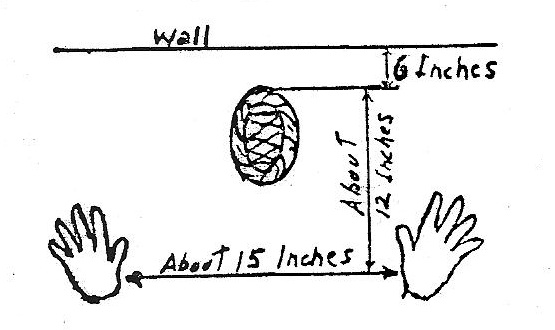
Position No. 1: Place the grommet on the floor about six inches from the wall, or at the foot of a bedstead (so your back will be about four to six inches from the wall when you are on your head; this keeps you from wasting too much time falling over and getting up again). Now place your hands on the floor, about 15 inches apart and about 12 inches nearer you than the grommet, and making a triangle with it – like a 3-legged stool. Point the fingers slightly outward; note the sketch for details. Bring the feet up to about 15 inches behind the hands; lift up from the hands and feet to the hands and head. (If you have never balanced in this position, allow the back to rest against the wall.) Keep the back as straight as possible (as in Fig. 4) and the shoulders back. Separate the legs as far as they will go comfortably, knees almost straight, and toes pointed; hold the feet about one a line with the hips.
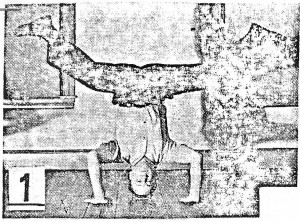
This is the easiest known position for begging the free head balance. Once you assume this try to bring the back (buttocks) away from the wall and to hold the position a short time before descending. Rest a bit, then repeat 6 or 8 times only, the first day. Increase a few repetitions each practice period until you accomplish 30 to 50, which will be enough.
Holding position 1 is done by maintaining a steady, even pressure on the head and hands, but as you try to shift more weight to the head you will find that balancing becomes less a matter of supporting yourself like a 3-legged stool, and more a feat of control by leg movement. To get the “feel” proceed to position Number 2.
Position No. 2: Note how naturally you balance by arm and leg motion; extend the legs as you roll over, draw them in as you move forward; draw in right arm and leg, and extend left members, as you fall right, and vice versa. This is exactly the manner of balancing on the head as you continue to position 3 you will find the leg action asserting itself.
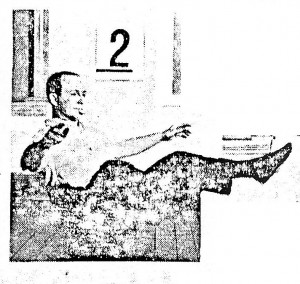
Position No. 3: Take the first position, but when you take the balance on head and hands use only the tips of thumbs and fingers, instead of flat hands, to assist the balance. Practice this style until it is easy. You will observe that a slight shift in the neck is now necessary; as you put more and more weight on the head you can no longer keep the neck and spine in the normal standing position, but must thrust the head forward to bring the center of your weight over the crown of you head.
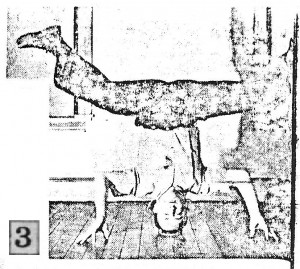
Position No. 4: This shows just how you legs, body and neck are carried in all subsequent positions, and illustrates the well-back arms and shoulders attitude of positions 6, 7, and 9.
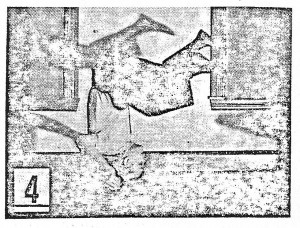
Position No. 5: Mount into the balance as in the past, only now use just the tips of the index fingers to aid in the balance. When you get good control, try it with the feet even a little higher than shown, depending less and less on the hands—and more and more on the leg action—to balance. You are now ready for…
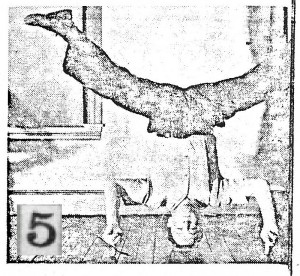
Position No. 6: The Free Head Balance! Start as usual through Positions 1-3-5, shoulders well back, and the back close to the wall to catch you in case of losing the balance forward. (If you topple in any other direction, catch with you hands.) Neither arch the back, nor yet hump it forward; keep it as in Fig. 4 Shift more and more weight to the head, more and more balancing to the legs; easy up with those two index fingers, and YOU HAVE IT!
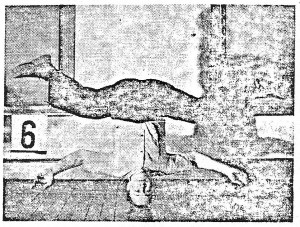
Position No. 7: Balancing is maintained, just as in position 2, by arm and leg action. If losing the balance to the left (as I am doing in Figure 7) draw in the left arm and leg and extend your right limbs; if toppling over, quickly straighten and raise both legs, while if falling back towards your starting position, draw in both knees well toward the chest.
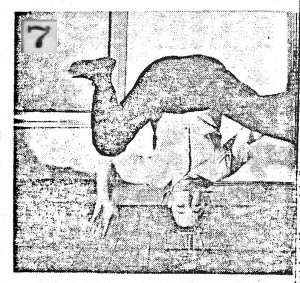
IN THE FREE BALANCE, rest the head on the grommet with slightly more weight on the back of the head—in other words, lean constantly over forward. This makes for steadier balance and better (higher) leg position. This is known professionally as “Pressing for balance”. Hold the arms out at right angles from the shoulders and slightly bent at the elbows; the hands, a little lower than the shoulders. See figures 4, 6, and 9. (Some athletes prefer keeping more weight toward the front of the head, but the professor and I greatly prefer the recommended style. Incidentally, keep your face about perpendicular, as in Figure 4; do not either stand on the forehead—as some “headstand authorities” insist—or roll over onto the back of the head. Neither position is good.)
Position No. 8: Once reasonably sure of the free balance, you can raise the arms and place the hands on the hips, as in this illustration. This is not difficult if you keep the shoulders well back, and the next step will be to try folding the arms on the chest, or placing them back of the body, or reaching out and catching one or both feet, and so on.
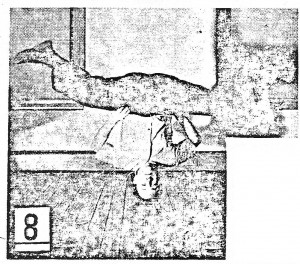
Position No. 9: You have now come to the point where your sense of balance is concentrated on the head; that is, you no longer depend so much on leg and arm action for balancing, and can “feel” the balance with the top of the head against the grommet. When you start losing your balance in a given direction, you press that side of your head more firmly against the grommet, and recover control and position. Commence raising the legs higher and higher until able to get them together as in the illustration. This demands new balancing technique.
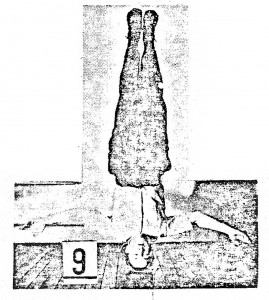
Position No. 10; Before mastering position 10 you will have to get away from the in-and-out leg action of figure 7. Try now to keep your knees locked straight (even more so than in figure 5). And balance by shifting them only at the hips. If falling to the left as in figure 8 you drop the left leg and raise the right leg as shown, solely by motion in the hip joint. The next step is to lock the entire hip assembly and use the legs as if one solid balancing pole, weaving right or left by waist action when you lose balance laterally. By now, your balance fore and aft will be almost automatically and will be done entirely by head pressure.
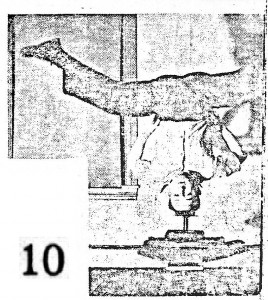
Position No. 11: Perfection! Professor Paulinetti as photographed in Italy around 1900; balance held entirely by head pressing and a slight lateral weaving, or swaying of the trunk. This is uncanny, fascinating—the mark of perfection in head balancing.
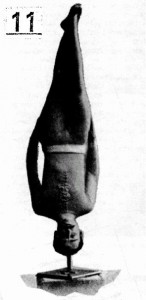
LONG BEFORE DUPLICATING the Professor’s headstand you will be sufficiently advanced to try different professional numbers—juggling, revolving balancing a rocker as in figure 10, the head balance trapeze, work with a partner and so on.
If you want more information from Professor Paulinetti and Bob Jones on balancing on your HANDS then I highly recommend you check out their book The True Art and Science of Hand Balancing. It has this much detail plus so much more.

Comments
I have never tried headstands, because I thought it looked too difficult, but I will try.
Question:- What is the benefit of doing headstands ?
@Larry Burns: Good question Larry. If you look at Yogic traditions all the inversion, of which headstands are one, are some of the highest rated moves. This is because you’re reversing the flow of gravity which has some very beneficial effects to it.
Headstands in the manner shown here will obviously improve your balance, which can help with any hand balancing you also might do.
They’ll also build a strong neck. People are too often scared of hurting their neck, which is understandable but I go the other way. If I don’t want to hurt it I will make it stronger and more resistant to any injury.
Those are some of the major benefits though there are others as well.
hi my names is tchesco im make head balance
this site is very cool
sorry for my ingles
take care and bey bey
where can i buy a gromet for my head?
@jay portnow: I haven’t found anywhere. It may be something you have to make yourself. However if there is enough interest I’m sure I could get them produced and sell them here. They’d probably be pretty cheap.
@jay portnow:
I have been making some doughnuts for a few people locally and am happy to sell them for £15 plus postage and packing. I’m based in the UK, so postage from here!
let me know if you’re interested.
Christopher, thanks for making this available, I’d be interested in the head-to-head as that would be a nice development to standing on head and headstand on feet that me and my acro partner are currently working on.
warm regards
jesse
Awesome! Looking forward to parts 2 and 3.
I was wondering, is there a PDF version of this so that I could download it and take it with me places?
@Tyciol: All three sections including a PDF version are available on this page: https://www.lostartofhandbalancing.com/articles/
Logan, I have few questions. One, how often should I practice head balancing? And two, do you sell head grommets? I thought I remembered reading that you have professional models. Anyways, let me know.
@Kevin: I answered your question on the about page too. For practicing if you really want to get good I’d recommend practicing everyday. I don’t currently sell head grommets but you should be able to find them elsewhere.
Thank you Logan! Do you know where I would be able to buy one? I am currently using a device I bought at Home Depot for cheap but I don’t believe it would work the same as a head grommet. Thank you again.
@Kevin: heel2hand.com